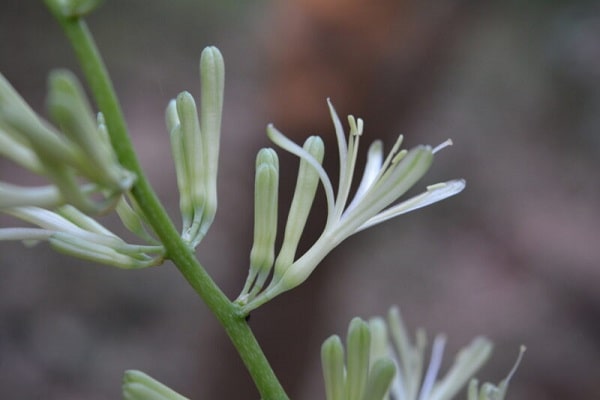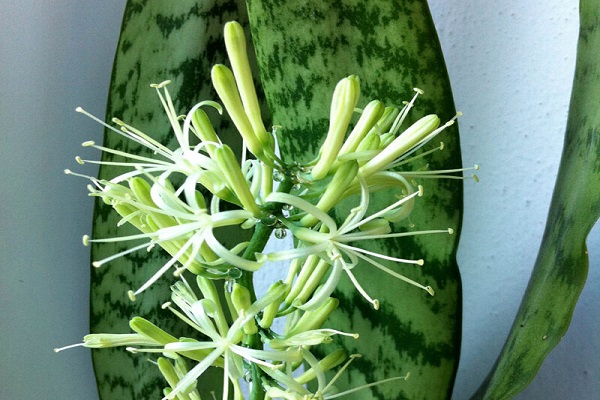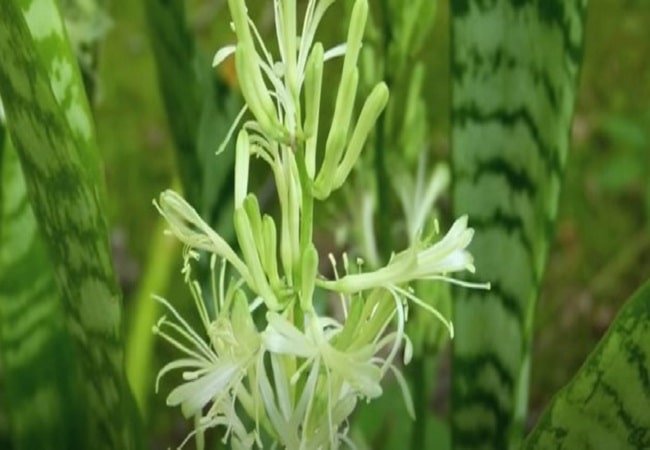Snake plants, or Sansevieria in their scientific name, are well-liked by indoor gardeners for their resilience, low-maintenance requirements, and effective indoor air filtration. Why do snake plants bloom ? These plants are characterized by their long, upright, and often variegated leaves, which create a striking visual effect. However, snake plants can produce blooms under the right conditions.
The reasons behind snake plant blooming are fascinating and involve various factors contributing to this unique phenomenon. This article will explore the conditions that encourage snake plant blooms, the blooming process, and the benefits of these flowers. This knowledge can help plant enthusiasts better understand and care for their snake plants, ultimately enhancing the beauty and health of their indoor gardens.
Quick Navigation
How Do Flowers Know When To Bloom

Flowers rely on environmental cues and internal biological processes to know when to bloom. The factors that influence the timing of blooming include:
Photoperiodism
Many plants respond to changes in day length, or photoperiod, to determine when to bloom. Some plants, known as short-day plants, flower when the nights are longer, while long-day plants flower when the nights are shorter. Day-neutral plants do not rely on photoperiodism to trigger flowering; instead, they bloom based on other factors, such as temperature or plant maturity.
Temperature
Temperature plays a crucial role in the flowering process. Certain plants require a specific range of temperatures, known as vernalization, to induce blooming. The temperature changes signal plants to transition from vegetative growth to reproductive growth. In addition, temperature fluctuations between day and night can also influence blooming.
Plant Hormones
The production of plant hormones, such as gibberellins, auxins, and abscisic acid, regulate various aspects of plant growth and development, including flowering. Depending on the plant’s specific needs and environmental conditions, these hormones interact in complex ways to stimulate or inhibit the blooming process.
Genetic Factors
A plant’s sensitivity to environmental signals and internal hormonal regulation is encoded in its DNA.Some plants have evolved to flower at specific times to maximize their reproductive success, synchronize with pollinator availability, or avoid competition for resources.
Plant Maturity
Many plants need to reach a certain level of maturity before they can flower.The plant’s vitality and resources are conserved in this way so that they can be used for fruit formation.
Environmental Stress
In some cases, plants may flower in response to environmental stress, such as drought or nutrient deficiency. This survival mechanism allows the plant to reproduce before it succumbs to adverse conditions.
Flowers know when to bloom through environmental cues and evolved internal biological processes to maximize their reproductive success and survival. These factors work together to ensure that flowers bloom optimally, increasing the chances of successful pollination and seed production.
Why Do Snake Plants Bloom Stages Of A Flower

The process of flower blooming involves several stages, each with its distinct characteristics and functions. Here is a general overview of the stages of a flower’s blooming process:
Bud Formation
The process begins at the shoot apical meristem, where undifferentiated cells divide and differentiate into various specialized cells.
The cells develop into a floral bud, the initial flower formation stage. Protective structures, such as sepals or bracts, may cover the bud.
Bud Growth
The cells within the bud continue to divide and grow, giving rise to different floral structures.
Plant hormones, such as auxins and gibberellins, play a crucial role in coordinating the growth and development of the bud.
Bud Opening (anthesis)
As the bud matures, the sepals and petals begin to expand and unfurl, revealing the flower’s intricate structure.The pigments responsible for the flower’s color, such as anthocyanins and carotenoids, are produced, and the fragrance compounds are released.
Flower Maturation
The pollen grains containing male gametes (sperm cells) are produced by the male reproductive structures, or stamens. The female reproductive structure, or pistil, houses the ovules containing the female gametes (egg cells).
Pollination
Self-pollination and cross-pollination, with the help of pollinators like insects, birds, and the wind, both involve the transport of pollen from the anther of one flower to the stigma of another.The ovules are fertilized when pollen lands on the stigma and germinates to produce a pollen tube that travels down the style.
Fertilization
The sperm cells are released from the pollen tube and fuse with the egg cells within the ovules, resulting in fertilization. The fertilized ovules develop into seeds containing the plant’s embryo and a food supply to support its growth.
Flower Senescence
As the seeds mature, the flower begins to senesce or age, and nutrients are redirected to the developing seeds. The petals and sepals lose their turgor, wilt, and eventually fall off, leaving behind the fertilized ovary.
Fruit Development
The fertilized ovary grows and expands to become a fruit, which houses and protects the developing seeds.
Once the fruit is mature, it may be eaten by animals or release its seeds through various mechanisms, such as wind or water, to initiate the next generation of plants.
These stages represent a general outline of the blooming process, which may vary depending on the specific plant species and environmental conditions. However, understanding these stages can provide insight into the intricate and fascinating process by which flowers bloom and reproduce.
Benefits Of Snake Plant Blooms
Snake plant blooms add a touch of beauty and elegance to the already attractive foliage of the plant. The delicate, tubular flowers usually grow in clusters on a long flower stalk and emit a pleasant fragrance. The flowers can be white, cream, or greenish-white in color, and their presence enhances the visual appeal of the plant, making it a focal point in any indoor or outdoor garden setting.
Snake plants are well-known for their air-purifying abilities, as they help remove toxins such as benzene, formaldehyde, and trichloroethylene from the air. While the primary air-purifying function is attributed to the leaves, the blooms contribute to the overall air-cleaning effect of the plant. By purifying the air, snake plants help create a healthier living environment, especially in indoor spaces with limited air circulation.
Although the primary medicinal properties of snake plants come from the leaves, the blooms may also offer potential health benefits. Some studies have suggested that the flowers of certain Sansevieria species exhibit antioxidant, antimicrobial, and anti-inflammatory properties. However, more study is required to establish the safety and effectiveness of snake plant blooms for various health applications and completely comprehend their potential medicinal uses.
Encouraging Snake Plants To Bloom

Providing the right growing conditions is essential to encourage snake plants to bloom. Make sure the plant is placed in an area with bright, indirect sunshine; direct sunlight might damage the plant’s leaves. Snake plants can tolerate low light levels but are more likely to bloom with adequate light exposure. Maintain a temperature range of 70-90°F (21-32°C) during the day and around 55-70°F (13-21°C) at night for optimal growth.
Regularly remove dead or damaged leaves to promote healthy growth and prevent diseases. Pruning also encourages the plant to direct its energy towards producing new growth and blooms. Avoid over-prune; removing too many leaves can stress the plant and hinder its blooming ability.
Feed your snake plant with a balanced, water-soluble fertilizer diluted to half strength every 6-8 weeks during the growing season (spring and summer). This provides essential nutrients that support overall plant health and encourage blooming. Ensure the soil drains well by mixing in with perlite, sand, or pumice.
Snake plants prefer slightly acidic to neutral soil (pH 6.0-7.0). needs and adjust its environment accordingly. If the plant is not blooming despite receiving proper care, try changing its location or adjusting the light and temperature levels to create mild stress. This can sometimes trigger blooming. Additionally, ensure the plant isn’t overwatered, as excessive moisture can lead to root rot and inhibit flowering. Water less frequently and let the soil dry up throughout the winter.
Common Challenges And Misconceptions
A common challenge faced by snake plant owners is the need for blooms. Although snake plants are not known for blooming frequently, providing the right conditions can increase the chances of flowering. Ensure your plant receives adequate light, proper temperature fluctuations, and appropriate care. It is important to note that snake plants may take several years to reach maturity and produce flowers. Patience and consistent care are key to encouraging blooms.
Overwatering is a common mistake snake plant owners make, leading to root rot and ultimately killing the plant. Snake plants are drought-tolerant and can go without water for extended periods. To omited overwatering, allow the soil to dry out between waterings and reduce the watering frequency during winter. A well-draining soil mix and pots with drainage holes can also help prevent overwatering and root rot issues.
Some snake plant owners may mistake emerging flower stalks for new leaves, mainly when the stalks are still small and surrounded by foliage. Flower stalks are typically thinner, more flexible, and have a different texture than the leaves. As the stalk grows, the flower buds will become more apparent, distinguishing them from new leaves. Awareness of this misconception can help snake plant owners correctly identify flower stalks and provide the necessary care to support blooming.
FAQs
Are Snake Plants Lucky Flowers?
Snake plants are considered lucky in some cultures, particularly in Feng Shui, where they are believed to bring positive energy, protect against negative forces, and purify the air. They are often placed near entrances or in corners to promote good fortune and overall well-being.
How Do I Know That The Snake Plant Is Happy?
A healthy and happy snake plant will have firm, upright leaves with a bright, even color and no signs of wilting, browning, or yellowing. Additionally, the plant will exhibit steady growth and under the right conditions, may produce blooms. Ensuring proper care, such as adequate light, appropriate watering, and suitable temperature, will help keep your snake plant happy.
How Do You Make A Snake Plant Bloom?
To encourage a snake plant to bloom, provide optimal growing conditions such as bright, indirect light, proper temperature fluctuations, and well-draining soil. Fertilize the plant with a balanced, water-soluble fertilizer during the growing season and practice proper pruning and grooming techniques. Occasionally, exposing the plant to mild stress, such as a slight change in location or temperature, can trigger blooming.
Do Snake Plants Only Bloom At Night?
Snake plants do not exclusively bloom at night. However, their flowers are more fragrant during the evening and nighttime hours, a characteristic of many night-blooming plants that rely on nocturnal pollinators like moths. The blooms typically last a few days to a week and can appear anytime, day or night.
Why Is My Snake Plant Not Blooming?
Several factors can contribute to a snake plant not blooming. These include insufficient light, temperature fluctuations, overwatering, or a lack of nutrients. Additionally, the plant may need to be mature enough to produce flowers, as it can take several years for a snake plant to reach blooming age. Ensuring proper care and growing conditions, as well as being patient, will increase the chances of your snake plant producing blooms.
Conclusion
snake plants bloom due to maturity, environmental conditions, and stress. The blooming process is a fascinating aspect of these popular houseplants, known for their hardiness and air-purifying properties. The flowers add aesthetic appeal, contribute to air purification, and offer potential medicinal benefits. By understanding the factors influencing snake plant blooming and providing proper care, plant enthusiasts can encourage their snake plants to produce these beautiful, fragrant flowers.

My name is Md Deloar Hossain and I’m the creator of Club Gardening, designed for all your gardening ideas, gardening product reviews, and a place to help you find the best gardening experience possible.


